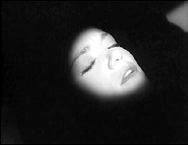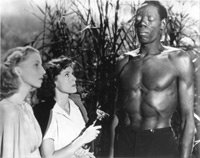 Start with Cat People (1942), a film that owes its atmosphere to Lewton, sure, but at least as much I like to think to the great Jacques Tourneur* who’s responsible for other Lewton masterpieces (The Leopard Man, I Walked with a Zombie), the great Mitchum noir, Out of the Past, and also one of the greatest single episodes of Rod Serling’s “Twilight Zone”: a little gem called “Night Call” wherein an old lady gets a series of whispery crank calls before discovering that her phone line has actually been severed and that the end of the wire lies across the grave of her dead husband. Yep. It’s awesome. The way that Tourneur shoots virginal (and exotic) Simon as Irena, a woman haunted by bad genes and a certain fairy-tale malady of tending to turn into a monster when she’s sexually aroused (something sort of hilariously fumbled by Paul Schrader’s remake if explored with verve in Neil Jordan’s The Company of Wolves), started a revolution in monster cinema: ironically relegating it (along with Tod Browning’s big-budget boondoggle Freaks) for all time into the realm of low-budget production I think, but also introducing the idea of “less is more” when the Universal Monster cycle was threatening to make it’s own Van Helsing sixty-some years before it actually did. Simon is wonderful, of course, but it’s Tourneur’s direction that makes every shadow from Central Park to a bus stop haven a menace, and its references to Kafka’s “The Hunger Artist” pop and crackle. No mean feat.
Start with Cat People (1942), a film that owes its atmosphere to Lewton, sure, but at least as much I like to think to the great Jacques Tourneur* who’s responsible for other Lewton masterpieces (The Leopard Man, I Walked with a Zombie), the great Mitchum noir, Out of the Past, and also one of the greatest single episodes of Rod Serling’s “Twilight Zone”: a little gem called “Night Call” wherein an old lady gets a series of whispery crank calls before discovering that her phone line has actually been severed and that the end of the wire lies across the grave of her dead husband. Yep. It’s awesome. The way that Tourneur shoots virginal (and exotic) Simon as Irena, a woman haunted by bad genes and a certain fairy-tale malady of tending to turn into a monster when she’s sexually aroused (something sort of hilariously fumbled by Paul Schrader’s remake if explored with verve in Neil Jordan’s The Company of Wolves), started a revolution in monster cinema: ironically relegating it (along with Tod Browning’s big-budget boondoggle Freaks) for all time into the realm of low-budget production I think, but also introducing the idea of “less is more” when the Universal Monster cycle was threatening to make it’s own Van Helsing sixty-some years before it actually did. Simon is wonderful, of course, but it’s Tourneur’s direction that makes every shadow from Central Park to a bus stop haven a menace, and its references to Kafka’s “The Hunger Artist” pop and crackle. No mean feat. Shot on the set of The Magnificent Ambersons for a pittance (less than 150 grand), it grossed over four million dollars – demonstrating something that still seems like a surprise to people (see Blair Witch Project): that if you tap into the zeitgeist – and genre pics are particularly able to do just that – you can make not only a mint, but a piece with lasting cultural significance. From there, go to The Leopard Man (1943) – actually the third Lewton/Tourneur, but one, based on a Cornell Woolrich novel, that finds itself most closely allayed to the themes of sexual repression introduced in Cat People. Its centerpiece a brutal attack of a young woman on her doorstep as her mother, from the inside, tries desperately to undo the bolt to let her in – the picture misses the wide-eyed foil of Simon’s forbidden fruit and the tragedy of unrequited love and the sins of the fathers. It’s good, in other words, with its serial killer one of the earliest iterations of the species in the mainstream “Code” flick (of course M was much earlier) – it might even be a classic – but it’s no Cat People. But I Walked with a Zombie (1943) might be. The second of the three Lewton/Tourneur collaborations, it
Shot on the set of The Magnificent Ambersons for a pittance (less than 150 grand), it grossed over four million dollars – demonstrating something that still seems like a surprise to people (see Blair Witch Project): that if you tap into the zeitgeist – and genre pics are particularly able to do just that – you can make not only a mint, but a piece with lasting cultural significance. From there, go to The Leopard Man (1943) – actually the third Lewton/Tourneur, but one, based on a Cornell Woolrich novel, that finds itself most closely allayed to the themes of sexual repression introduced in Cat People. Its centerpiece a brutal attack of a young woman on her doorstep as her mother, from the inside, tries desperately to undo the bolt to let her in – the picture misses the wide-eyed foil of Simon’s forbidden fruit and the tragedy of unrequited love and the sins of the fathers. It’s good, in other words, with its serial killer one of the earliest iterations of the species in the mainstream “Code” flick (of course M was much earlier) – it might even be a classic – but it’s no Cat People. But I Walked with a Zombie (1943) might be. The second of the three Lewton/Tourneur collaborations, it reminds me an awful lot of Jean Rhys’ The Wide Sargasso Sea in its suffocating atmosphere and feeling of encroaching, inexorable dread. A zombie film that is, like the best of ‘em, about something else. It’s empirically obvious that zombies – especially just one zombie – don’t really pose any kind of threat to us (something that the end of Shaun of the Dead lampoons hysterically), that they can’t catch us – the traditional kind anyway – and once catching us, they seem to be able to be shaken off fairly easily.
reminds me an awful lot of Jean Rhys’ The Wide Sargasso Sea in its suffocating atmosphere and feeling of encroaching, inexorable dread. A zombie film that is, like the best of ‘em, about something else. It’s empirically obvious that zombies – especially just one zombie – don’t really pose any kind of threat to us (something that the end of Shaun of the Dead lampoons hysterically), that they can’t catch us – the traditional kind anyway – and once catching us, they seem to be able to be shaken off fairly easily.And yet they do catch us – and they do injure us and, worse, they convert us when they do. I’ve spilled a lot of ink on what I think are the similarities between zombies and the Christian myth – but without getting gory again, best to say that there’s something at work here in I Walked with a Zombie (the title a play on the Christian walk, perhaps?) that’s thorny and elegant. It’s scary, too.
Next up, the two flicks that Robert Wise did with Lewton (Curse of the Cat People and The Body Snatcher) – as well as Bedlam which, in its double and triple dissolves, sets a new precedent in the language of horror. Will do a little dance about The Seventh Victim and The Ghost Ship - hopefully just in time for Halloween.
Sunday Feature
Ira Sachs

5 comments:
Dan:
You're kind to call it a typo - I do it four times. Closer to the truth that I just didn't know how to spell his name! Thanks for the correction.
I know it's not a Lewton production, but have you seen Tourneur's Night of the Demon? It's fantastic, for me his second best after Out of the Past.
Dude, the screenshot in Walter's next post is from Night of the Demon.
d'oh
Simon is remarkable in it, isn't she? Agreed that the sense of melancholy and loneliness is palpable. The bus stop scene is an all-timer.
Tell me more about these BBC 2 double bills.
Post a Comment